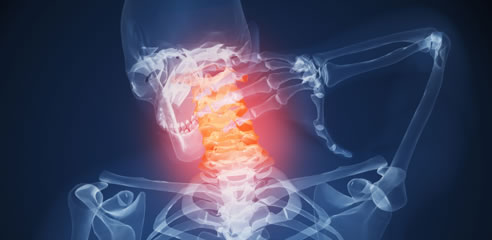
|
|
|
Call our offices at: (310) 274-3481 (800) 964-0404
Beverly Hills
9301 Wilshire Boulevard
Suite 406A
Beverly Hills, California 90210

|
|
 |
|
|
INSURANCE & WORKERS' COMPENSATION
ACCEPTED!
We accept most types of
insurance
providers and specialize in the treatment of
workers' compensation injuries to the hand and upper extremity. |
|
 |
|
Neck Pain
Cervical Radiculopathy
Cervical Facet Syndrome
Cervicothoracic Interspinous Bursitis
Cervical Strain
Fibromyalgia of the Cervical Musculature
Our neck is a complex network of seven cervical vertebrae, discs, ligaments, muscles, nerves and blood vessels. It allows for a significant amount of motion and supports the weight of the head, and is often susceptible to trauma or injury. Neck pain is a common complaint among patients. Often times the cause is minor and can be a simple muscle sprain or soft tissue abnormalities, however, more severe problems, such as nerve impingement or ruptured discs, may exist and will require the care of a physician. Listed below are common disorders associated with neck pain that will require the care of specialized physicians, such as the team at Avosant Surgical Associates.

Cervical Radiculopathy
Cervical radiculopathy refers to a condition consisting of pain in the neck and upper extremities that emanates from cervical (neck) nerve roots. This condition is also referred to as a ‘pinched nerve’ and the pain is described as sharp and often radiating. Patients who are suffering from cervical radiculopathy may also experience associated numbness, loss of reflexes, and weakness. The causes of cervical radiculopathy stem from any condition that puts pressure on the nerves as they exit the spinal cord in the neck including disc herniation, degeneration of the vertebrae, spinal instability, tumor, and rarely, infection. Diagnosis of cervical radiculopathy includes a complete history and physical examination,an MRI of the cervical spine, and nerve conduction studies. Advanced treatments for cervical radiculopathy include a muti-disciplinary approach including physical therapy, nonsteroidal anti-inflammatory agents, muscle relaxants, and in many cases a cervical epidural block or other more advanced minimally invasive pain management treatments. At Avosant Surgical Associates, our highly qualified pain management specialists can create a treatment regimen and guidance to fit the special needs of each individual patient.
Cervical Facet Syndrome
Cervical facet syndrome is a condition consisting of multiple symptoms of neck, shoulder, head and upper extremity pain due to an anomaly or pathology of the cervical facet joints. The pain is described as dull and is aggravated by flexion (bending forward), extension (bending backward), and lateral (side to side) bending or twisting of the neck muscles, as well as a decrease in the range of motion of the cervical spine. Patients may also experience tenderness to deep palpation and spasms of the cervical muscles. Diagnosis of cervical facet syndrome is achieved by obtaining an MRI of the cervical spine as well as diagnostic intra-articular injection of the suspect facet joints. Treatment for this condition is best achieved through a multi-disciplinary approach including physical therapy, nonsteroidal anti-inflammatory agents, and skeletal muscle relaxants. In some cases, patients must undergo cervical facet blocks. Surgery is only indicated in the most severe cases which show no improvement with conservative management.
Cervicothoracic Interspinous Bursitis

Cervicothoracic interspinous bursitis is an uncommon condition involving pain in the lower cervical and upper thoracic spine and the pain associated is described as constant, dull, and aching in nature and does not radiate. Bursitis as a condition occurs when the bursa, small fluid-filled pads among bones, tendons and muscle near joints, becomes inflamed. When overused, the interspinous ligaments of the lower cervical and upper thoracic spine and the associated muscles are prone to developing acute and chronic pain. Diagnosis of cervicothoracic interspinous bursitis is generally made on clinical grounds through means of exclusion, including an MRI of the lower cervical and upper thoracic spine. Treatment involves a combination of nonsteroidal anti-inflammatory agents and physical therapy. In some cases, patients may require an injection of the cervicothoracic bursae. It is extremely important for any patient suspect of suffering from cervicothoracic interspinous bursitis to receive proper care from a qualified medical specialist.
Cervical Strain
Cervical strain is a condition that involves pain of the neck and radiates to the shoulders and intrascapular region and is often accompanied by a headache. The pain is aggravated by movement of the shoulders and cervical spine. It is commonly caused by trauma to the cervical spine and associated soft tissues, however in some cases there may be no obvious incident. Cervical strain is diagnosed with a combination of a clinical history and physical exam and an MRI of the cervical spine. Treatment for cervical strain is best achieved through a multi-disciplinary approach including physical therapy, nonsteroidal anti-inflammatory agents, skeletal muscle relaxants, and occasionally a cervical epidural block and/or intra-articular injection of the facet joint.
Fibromyalgia of the Cervical Musculature
Fibromyalgia is a very common chronic pain condition that affects a regional portion of the body. Fibromyalgia of the cervical spine is characterized by having absolute myofascial trigger points that are thought to be the result of microtrauma to the affected muscles. When stimulated, these myofascial trigger points will induce or enhance the patients pain. Stiffness and fatigue, as well as psychological and behavioral abnormalities, frequently coexist with the pain of fibromyalgia of the cervical spine and must be appropriately treated. The cause of fibromyalgia of the cervical spine is unknown, however, there is indication that tissue trauma may be a leading factor. Diagnosis of fibromyalgia of the cervical spine is made on the basis of a complete and targeted history and physical examination with a complete systemic search of trigger points and identification of a positive jump sign (involuntary withdrawal of the stimulated muscle). Treatment of fibromyalgia of the cervical spine uses a technique to interrupt the pain cycles by eliminating the trigger points associated such as the use of regional blocks or botox. Treatment for this condition is unique for each patient. At Avosant Surgical Associates, our team of pain management specialists can devise a specialized treatment plan in order to diminish the pain associated with fibromyalgia of the cervical spine.

Top of the Page |
|